Planning to visit the MET in New York City but unsure what famous artwork you should see? Don’t worry, we are MET experts so we have you covered. Here are the most famous sculptures that you absolutely positively should not miss when visiting the Metropolitan Museum of Art.
Pro Tip: It’s easier to organize your trip when you have all your resources in one place. Bookmark this post along with our guide to New York City for more planning resources, our best MET and NYC tours for a memorable trip, and the top things to do in NYC.
The Top 21 Pieces of Art To See at the MET in NYC
Art is about emotion. It is an artist unleashing their innermost thoughts and feelings onto the art piece for all to witness. It is such a powerful act, that many have been criticized, scrutinized, and even killed just for doing the act.
However, few actually see it, and even fewer understand. If you look at the sculpture and don’t feel anything, that is because you haven’t heard its story. This is the very reason we recommend guided tours.
If you hear the story and don’t get chills, then it is not great artwork. Its purpose is to inspire emotion. You don’t have to have a strong art background to appreciate art. It definitely helps, but it is not essential.
You can make your visit memorable by joining a guided tour of the MET. We work with guides who have strong art backgrounds, are skilled in the art of story-telling, and, above all, having fun.
Not ready to book a tour? Find out if a Met tour is worth it.
21. Autumn Rhythm (Number 30)
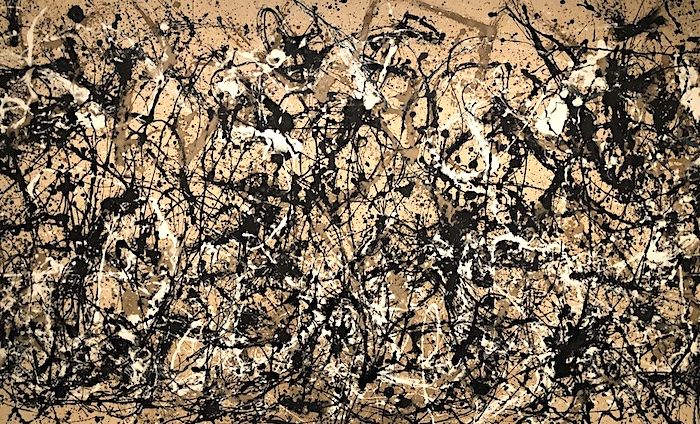
Jackson Pollock | 1950 | Enamel on Canvas | Gallery 919
The number 1 complaint I hear about modern art and especially artists like Jackson Pollock is- ” I don’t see anything besides some paint thrown on a canvas”. Usually the people who say this are new to modern art and are more used to a coin I termed as ” Literal Art”. Literal art is a painting of a defined image such as a person, animal, or landscape. When you look at those images, you can identify with them, since you have seen similar images throughout your life.
Artists at the turn of the 20th century were looking for new ways to express an idea. In addition, they were searching for new techniques to express this idea. Still with me?
Autumn Rhythm (Number 30) uses a technique called ” Pouring”. According to the Encyclopedia Brittanica, ” In 1947 Pollock first used the process of pouring or dripping paint onto a flat canvas in stages, often alternating weeks of painting with weeks of contemplating before he finished a canvas. This process allowed him to record the force and scope of his physical gesture in trajectories of enamel or aluminum paint.
The MET official archives says this about the painting, ” This work’s title suggests not only the month in which he painted it (October), but also an alignment with nature’s constant flux”. I couldn’t agree more.
“I intend to paint large movable pictures which will function between the easel and the mural. . . . the tendency of modern feeling is towards the wall picture or mural.
Jackson Pollock
20. No. 13 (White, Red On Yellow)
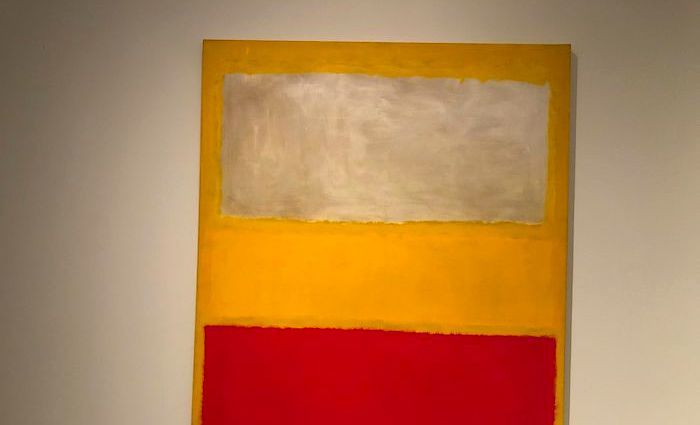
Mark Rothko | 1958 | Oil and Acrylic with Powdered Pigments on Canvas | Gallery 919
I will admit that I prefer Renaissance art to modern art. However, as I have gotten older ( and wiser) I have learned to appreciate modern art more. One of the artists who has pulled me over to the dark side ( or light side depending on how you look at it) is Mark Rothko.
Unfortunately he suffered from severe depression and anxiety. He was a heavy drinker and smoker and at the age of 66 he committed suicide. Unlike many artists, he had enjoyed success during his lifetime as an artist.
“No. 13 (White, Red on Yellow)” as the name suggests uses three primary colors. By using these bright colors, he is creating a joyous mood as opposed to other paintings where he choose darker colors for a more brooding nature. The vertical display shows broad stripes of red and yellow which almost seem to be hovering and not touching the painting. This “halo” technique was possible by having the horizontal bands overlap background color.
According to the MET Official Archives the halo effect, ” It is also enhanced by the translucency of the paint, which was so diluted that it actually saturated and stained the fibers of the canvas”.
“I’m interested only in expressing basic human emotions—tragedy, ecstasy, doom, and so on,” he declared. “And the fact that a lot of people break down and cry when confronted with my pictures shows that I can communicate those basic human emotions….If you…are moved only by their color relationships, then you miss the point.
Mark Rothko
19. Gertrude Stein
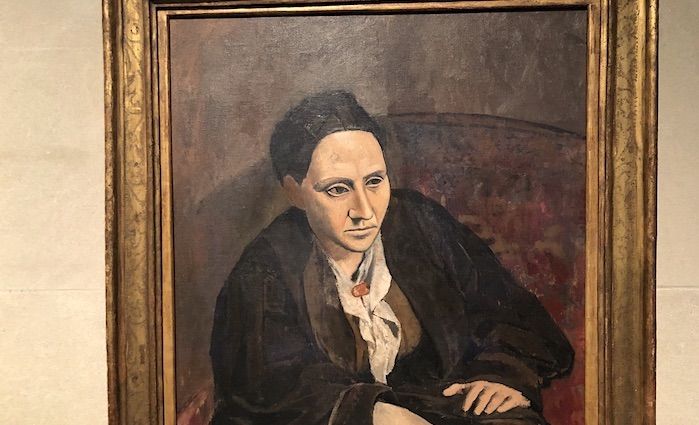
Pablo Picasso | 1906-1906 | Oil on Canvas | Gallery 830
Sometimes looking at artwork gives you a look into the past. For example, before I saw this painting, I had no idea who Gertrude Stein was. After reading up on her, I was fascinated by her history and life. She grew up between the United States and France and even when to John Hopkins Medical school. That sounds normal enough nowadays but this took place back at the end of the 19th century!
She hosted a salon in Paris which drew in some of the most important literary and artistic figures of the time. According to the Encyclopedia Brittanica, ” Her literary and artistic judgments were revered, and her chance remarks could make or destroy reputations”.
According to the MET official archives, ” For Picasso, Stein’s early patronage and friendship were critical to his success”. He painted her during his so-called ” Rose Period”. By studying this painting you can see how Picasso is slowly moving on to Cubism by reducing her body to simple masses. His study of Iberian sculpture is also prevalent here by portraying her face like a mask with heavy-lidded eyes.
Einstein was the creative philosophic mind of the century, and I have been the creative literary mind of the century
Gertrude Stein- American Writer
18. Young Mother Sewing
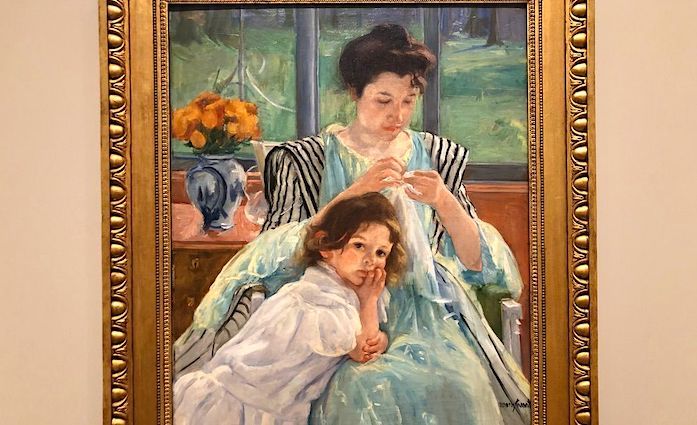
Mary Cassatt | 1900 | Oil on Canvas | Gallery 768
Mary Cassatt was one of the trailblazing female painters of the late 19th century. At that time, it was still frowned upon for women to have a profession as a painter. For example, she remarked at the Pennsylvania Academy of the Fine Arts in Philadelphia women students were patronized and were not allowed to work with live models. Fed up, she moved to Paris, but even in avant-garde Paris she wasn’t allowed to attend the Ecole des Beaux-Arts.
Therefore she started working privately with masters Jean-Leon Gerome and after Charles Chaplin. She befriended many of the Impressionist artists such as Degas, Pissaro and Monet.
As a father, there is something extremely delicate when you see a young mother and child together. Towards the end of the 19th century, Cassatt dedicated her energies towards painting women taking care of children and also children alone. For this painting, Cassatt brought in two unrelated models to act as mother and daughter. Sometimes the mundane creates a feeling of closeness to an experience we all have felt at some point. The simple moment these two figures are sharing is something millions of daughters and mothers have felt throughout time. I feel that Cassatt captures that perfectly here.
Look at that little child that has just thrown herself against her mother’s knee, regardless of the result and oblivious to the fact that she could disturb ‘her mamma.’ And she is quite right, she does not disturb her mother. Mamma simply draws back a bit and continues to sew.
Louisine Havemeyer- Purchaser of the Painting in 1901
17. Woman With A Parrot
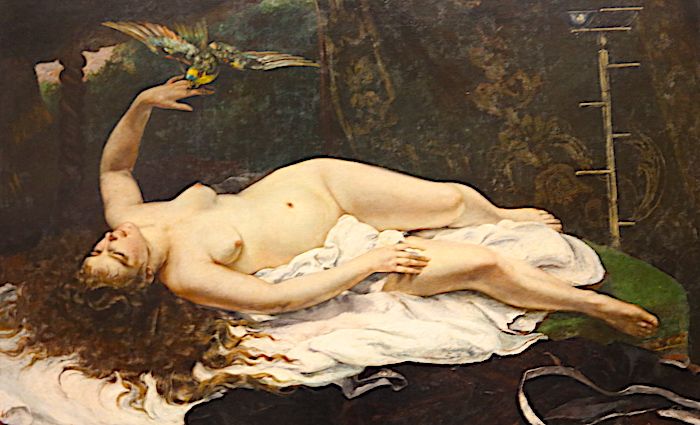
Gustave Courbet | 1866 | Oil on Canvas | Gallery 811
If Gustave Courbet had been alive in the 1980’s he probably would have been part of the Detroit Pistons ” Bad Boy” squad. How can you not like a guy who proclaims himself to be the, “proudest and most arrogant man in France”! I love this painting but definitely loved it more once I read that about the artist. Courbet was definitely out to shock and awe the French art world and he succeeded.
It all started in 1850 when Courbet displayed a group of large-scale paintings depicting regular day life. Today, this doesn’t seem very extraordinary. However, back in the day, these large-scale paintings were only historical genres. He further angered critics when he used his 3 sisters. ( They were peasants and he called demoiselles (young ladies). The critics told him that the girls were ugly and he needed to respect the differences in class boundaries. He called them a noble title which was a faux pas. He didn’t listen.
Courbet was such a bad-ass that he refused the award of the Legion of Honor, declaring himself independent of any form of government. Later in life, due to his political activities, the government arrested him and sentenced him to six months in jail. He eventually went into voluntary exile in Switzerland and died there in 1877. What a life and definitely not the typical one for an artist!
” Woman with a Parrot” received negative reviews such as “lack of taste” as well as his model’s “ungainly” pose and “disheveled hair.” However, the younger art generation embraced him. This is was due to their mutual disdain for academic standards. Manet started a similar painting the same year and supposedly Degas carried a small photograph of this art piece in his wallet!
Check Out Our Best New York City Tours

Top Rated Tour
Before the Crowds Statue of Liberty and Ellis Island Tour
On this tour you will visit the Statue of Liberty and Ellis Island with roundtrip ferry transport included all with a local guide who will describe the city’s amazing history as you visit the picturesque monument.





(10)
Starting at $59
Not ready to book a tour? Find out if a tour of the MET is worth it.
16. The Musicians
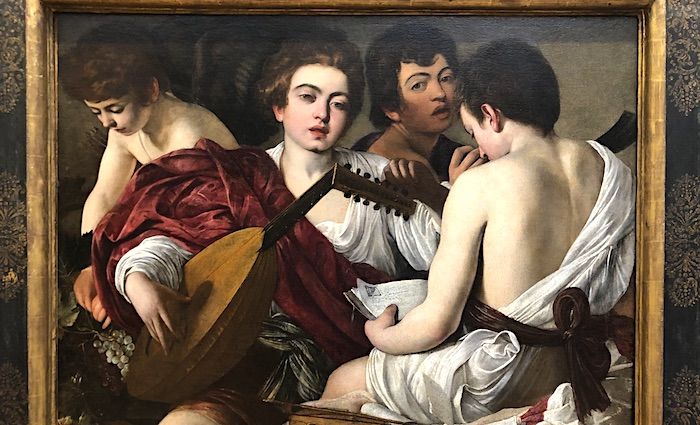
Caravaggio ( Michelangelo Merisi) | 1597 | Oil on Canvas
Caravaggio would have been the kind of dude you want to hang out with at a bar. But probably would not want to introduce to your family. Caravaggio’s life was anything but usual. For example, he walked around Rome with a sword, was supposedly part of a local gang, and even killed a man in a duel.
As a result of the killing, he was forced to flee Rome and traveled south painting along the way from Naples, to Sicily to Malta and back. As the legend goes, he was waiting for a pardon from Pope Urban VIII when one of his enemies finally caught up with him and killed him in Porto Ercole.
It would be difficult not to write an entire book about this painting or about Caravaggio’s artwork in general. Up to now, there were set templates of how to paint saints and holy people (being painted with ideal beauty and purity). Caravaggio smashed these concepts into the ground by painting saints and holy people as ordinary people with ordinary defects. This revolutionary idea forever changed the art world.
The Musicians is an earlier work by the master and resembles the paintings of youths you can see in the Borghese Gallery in Rome. A contemporary of Caravaggio, Giovanni Baglione, wrote that the artist, painted, ” a concert, with some youths portrayed from nature very well”. Most likely this is the painting in question. Interestingly Caravaggio makes a cameo here as the 2nd boy to the right!
15. Bacchanal: A Faun Teased by Children
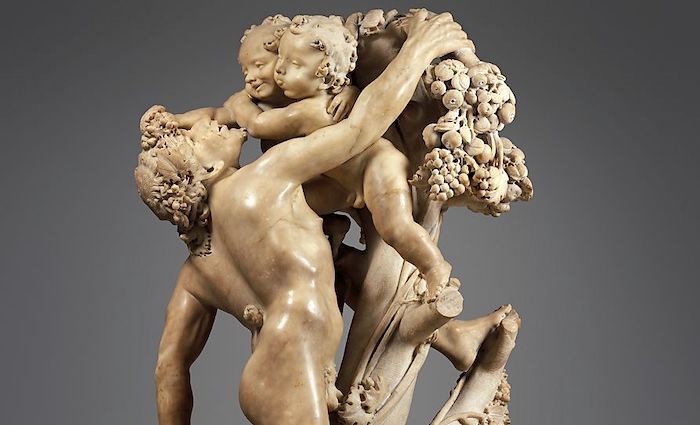
Gian Lorenzo Bernini | 1616–17 | Marble | Gallery 534
Gian Lorenzo Bernini was like King Midas- almost anything he touched turned to gold. He was by far the most prolific and famous sculptor in the Italian Baroque Period. Bernini was only 18 years old when he created this, therefore it contrasts with his later works which are more refined.
Needless to say, being 18 years old and creating something of this caliber is quite impressive. You can already see his attention to minute detail and the expressiveness of the figures. Therefore this is a foreshadowing of his Santa Teresa or Apollo and Daphe which are in Rome.
“Bacchanal: A Faun Teased by Children” is a playful statue where a Faun appears to be at the mercy of two small children. A Faun is a mythical forest creature and therefore even a bit ironic that human children would be playing with it. Starting back in the Hellenic age, adding children to artwork became quite popular and had a resurgence during the Baroque period.
The influence of his father, the Florentine-born Pietro, can be seen here in the buoyant forms and cottony texture of the Bacchanal. The liveliness and strongly accented diagonals, however, are the distinctive contribution of the young Gian Lorenzo.
MET Official Archives
14. Venus And The Lute Player
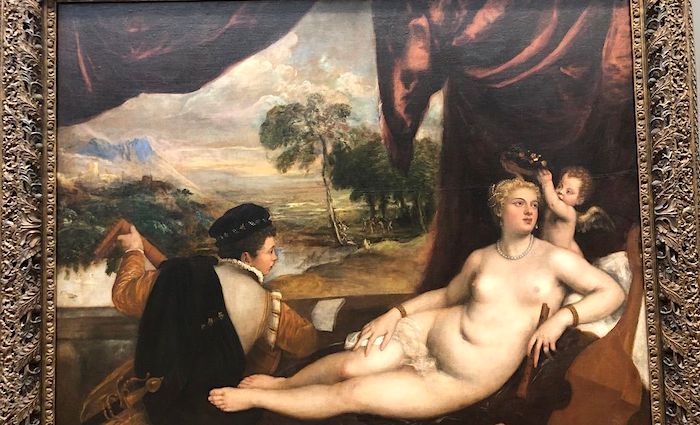
Titian | 1565-70 | Oil on Canvas | Gallery 608
Titian is by far one of the most famous Italian Renaissance painters of all time. Known for his sensual and voluptuous paintings of women, he was the reigning artist king of Venice during his lifetime.
Titian continued the transition in artwork of his time from the Virgin Mary to Venus. Whereas all paintings in the early Renaissance would have pictured the saintly mother of god, later Renaissance works started to idolize Venus as the reigning Matriarch of beauty.
“Venus and the Lute Player” shows Venus, the goddess of love, surrounded by a lute player and her son cupid. In Renaissance times, the lute was the go-to instrument when writing or singing songs of love. You can imagine the famous traveling troubadours playing their pained songs of love to any damsel who would listen to them!
Titian captures the moment here where Venus takes a break from the lute player who is affectionately staring at the goddess of Love. At that moment cupid crowns Venus with a wreath of flowers. In the background, you can see satyrs and nymphs dancing to the song of a shepherd. If you have seen other paintings of Titian, some of his most famous are those of a sensual, naked woman in a slightly reclining pose looking off in the distance. According to the MET Official Archives, “Once believed to allude to contemporary debates concerning “seeing” versus “hearing” as the primary means for perceiving beauty, these pictures seem mainly to celebrate sensual pleasures”.
Having learned that female beauty, adorned or natural, would always find customers, Titian pursued the theme joyously.
Will Durant- Historian
13. Burghers of Calais
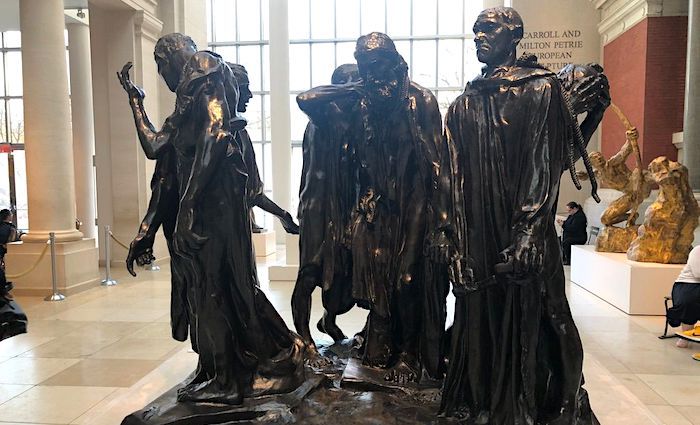
Auguste Rodin | modeled 1884–95, Cast 1985 | Bronze | Gallery 548
Auguste Rodin remains arguably the most famous French sculpture to date. He is most famous for his sculpture The Thinker which is located at the Rodin Museum in Paris, France.
I personally find the story behind the “Burghers of Calais” fascinating! English king Edward III (1312–1377), besieged the French town of Calais. Once the city surrendered, the king ordered the 6 most prominent citizens ( Burghers) to come to him. They also had to bring the keys of the city, with feet bare and ropes around their neck. The rope signified that the king ordered them to be beheaded!
Imagine the feeling of dread you would have knowing that you are walking out to certain death? However, not all is bleak. Unbeknownst to the Burghers, the English queen Philippa intervenes on their behalf to release them!
Rodin’s masterpiece displays the difficult arrangement of the figures. Some are looking straight ahead, while others are looking to the side. Some are in motion while others are standing still. This variety in one sculptural group expresses his mastery of various movements that he cast in Bronze.
Not ready to book a tour? Find out if a guided tour of the Met is worth it.
12. Portrait Of A Woman With A Man At A Casement
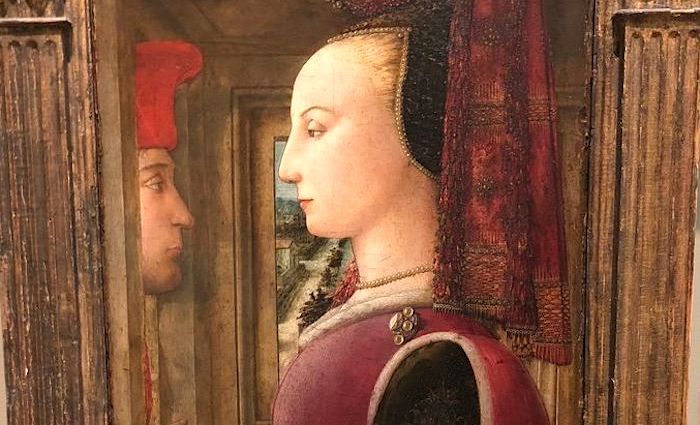
Fra Filippo Lippi | 1440 | Tempera on Wood | Gallery 602
The life of Fra Filippo Lippi is as fascinating as reading a book, if not even more so! Orphaned at a young age, his aunt gave him over to a monastery. According to Giorgio Vasari, pirates kidnapped him and help him for 18 months as a slave until he painted a portrait of his owner.
Later in life, he had quite the scandal since he ended up having a relationship with a young nun, Lauri Buti. Apparently, he was caught and tortured and was only released after Cosimo de Medici stepped in to save him! On a side note, the union of the painter and his nun lover resulted in them getting married and having a son, Filippino Lippi who was a magnificent painter in the later 15th century.
According to the MET Official Archives, “Portrait of a Woman with a Man at a Casement is the earliest surviving double portrait in Italy, the first to show the sitters in a domestic setting, and the first with a view onto a landscape”.
On the woman’s sleeve you can see the letters ” Lealta” (loyalty). There is a man who is staring at her ( almost uncomfortably close) at the window, so maybe this is her bethrothed? His hands are touching a coat of arms, which I am sure back in the day would have been recognizable to many who viewed this painting. Many art historians feel that this couple may be Lorenzo di Ranieri Scolari and Angiola di Bernardo Sapiti, who were married about 1439.
Lippi’s task was complicated by the Italian preference for the profile view as opposed to the three-quarter view preferred north of the Alps.
MET Official Archives
11. Dancing Celestial Deity (Devata)’
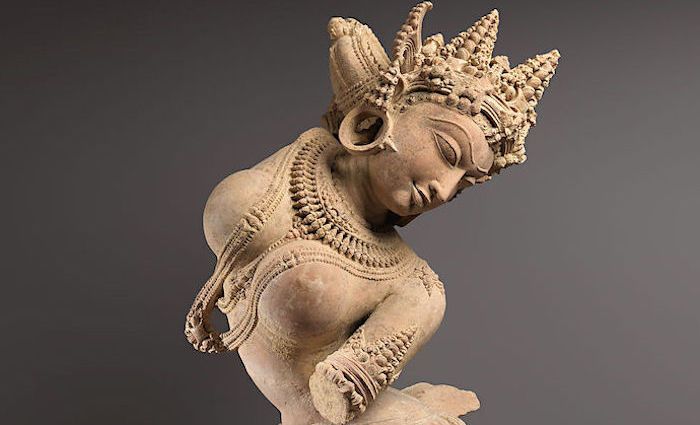
Unknown | Mid-11th Century | Sandstone | Gallery 241
The “Dancing Celestial Deity” would make Gumby proud. The body twists and distorts in a way that is definitely not human, which is the point. I’ll explain.
The Dancing Celestial Deity or Devata is performing a dance in honor of the gods. This life-size sculpture would have been placed inside a Hindu temple. Since a Hindu temple is the heavenly home of a presiding deity, the Devata is there to honor the god.
Why are the dancer’s legs going to the right while the torso and head are turning to the left? The sculptor would have contorted the dancer’s face and body according to prescribed canons of beauty. This is similar in Renaissance Christian art where a woman would be depicted with blond hair and very voluptuous. According to the MET’s official archives, ” The extreme flexion reflects dance positions (karunas and sthanas) described in the Natyasastra, an ancient dramatic arts treatise. It is understood in Indian aesthetics that such positions enhance the appreciation of beauty”.
10. The Dance Class

Edgar Degas | 1874 | Oil on Canvas | Gallery 815
Every time I look at this painting I get the ABBA song ” Dancing Queen” in my head! Dance was an obsession for the painter Degas and there is a similar painting about dancers in the Musée d’Orsay. In the movement and form of graceful ballerinas, he pushed forward the possibilities of Modernist art.
In the “Dance Class” you see a group of girls and their mothers who are standing around and watching the practice of one young girl. Watching the dancer is the famous ballet master Jules Perrot. While more than 100 years have gone by you could easily picture a scenario like this today in a ballet school. Young ballerinas practicing their routine, chatting with their friends, and watching the other girls dance. However, the rehearsal room depicted here would have been inside the old Paris Opera, which had recently burned down at the time of the painting.
Degas invites us to follow these scenarios as the natural lines of the painting guide our eyes to the back wall of the studio. The work is ultimately one of imagination.
9. The Temple of Dendur
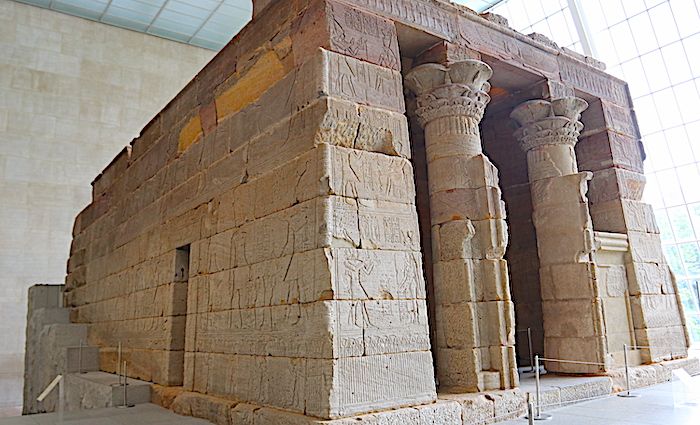
Unknown | 10 B.C. | Aeolian Sandstone | Gallery 131
I have to give huge props to the museum curator who organized the installation of the “Temple of Dendur” at the MET. Usually, to witness a life-size temple you would have to go on-site, in this case to Egypt. However, the MET has brought Egypt to New York City! They set it up so that you only see the temple after making a sharp left turn. At that point, a gigantic temple opens up in front of you.
In the 1960s the Egyptian government wanted to control the flooding of the Nile river. Therefore they built the Aswan Dam. However, a dam creates a lake that would have covered archeological sites, including Dendur where this temple comes from. Many countries came together to help Egypt with supplies, equipment, and funds to map out the ancient territories in this area. To show their appreciation to the United States for their help, the Egyptian government gave as a gift this temple and gateway!
Once you are in the gallery, you will be astonished at the size of the gateway and temple itself. The year of its construction is 15 BC which means that it was built during the Roman occupation. The little temple itself is dedicated to the goddess Isis together with Pedesi and Pihor, deified sons of a local Nubian ruler. If you are a Roman History nerd then you will be pleased to know that Emperor Augustus is also mentioned in this temple! The depiction of the Pharaoh is none other than Augustus, the first emperor of Rome!
Not ready to book a tour? Find out more about how to visit the MET museum.
8. Perseus with the Head of Medusa
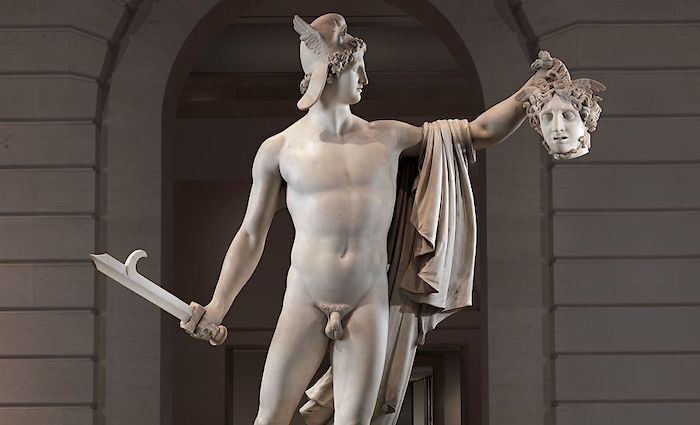
Antonio Canova | 1804–6 | Marble | Gallery 548
The Countess Valeria Tarnowska of Poland purchased this replica of Perseus. The original Perseus that Canova made is in the Vatican Musuems.
Canova took his inspiration for this piece from Greek mythology. Perseus was the slayer of the Gorgon Medusa and rescued Andromeda from the sea monster. He was a demi-god being the son of Zeus and Danaë. A wily king tricked Perseus to obtain the head of Medusa.
Since her gaze turned anyone to stone, he guided himself to her by the reflection of his shield. He then beheaded her while she slept. Canova chose this victorious moment for his art piece.
Like most artists before him, Canova would have been extremely influenced by classical artists. While today, artists can freely visit a museum, back in the 18th century the best place to visit where the Vatican Museums. A perfect example of influence for this statue is the Apollo Belvedere from the Vatican. The refined, noble face is almost a direct copy from the Apollo.
7. Ugolino and his sons
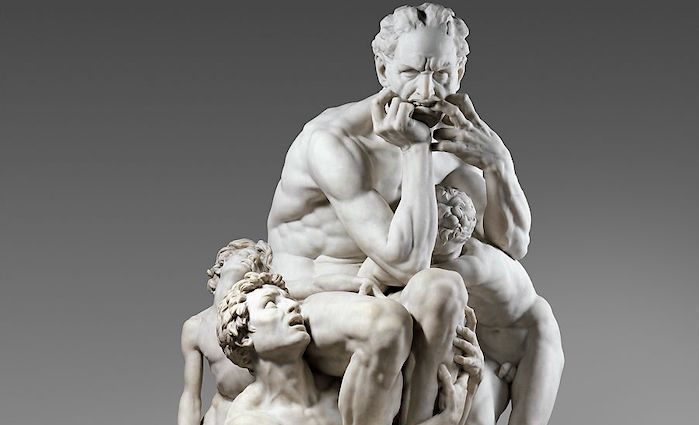
Jean Baptiste Carpeaux | 1865–67 | Saint-Béat marble | Gallery 548
Personally, I feel that few statues can express true pain and fear. Ugolino and his sons capture this in a way that is similar only to the Laocoon. Read below to understand the story behind this.
According to the Encyclopedia Britannica, ” Jean Baptiste Carpeaux’s works, contain a lively realism, rhythm, and variety that were in opposition to contemporary French academic sculpture, and form a prelude to the art of Auguste Rodin, who revered him.
The theme for “Ugolino and his sons” goes back to the 13th-century work by Dante, Divine Comedy. Officials ordered the Pisan count Ugolino Della Gherardesca, his sons, and his grandsons to prison for treason. It is in the prison that they died of starvation. In the XXXIII canto of Inferno, Dante mentions this horrible story.
Carpeaux studied art in Rome. In this piece, you witness the influence of previous masters on him. You can see from the abundant muscles and minute detail that Carpeaux was an avid follower of Michelangelo. This is especially true concerning Michelangelo’s Last Judgment in the Sistine Chapel in the Vatican.
“The grip of all of these people, the density of this composition, communicates the crisis.”
Sam Pinkleton-Theater director
6. The Gulf Stream
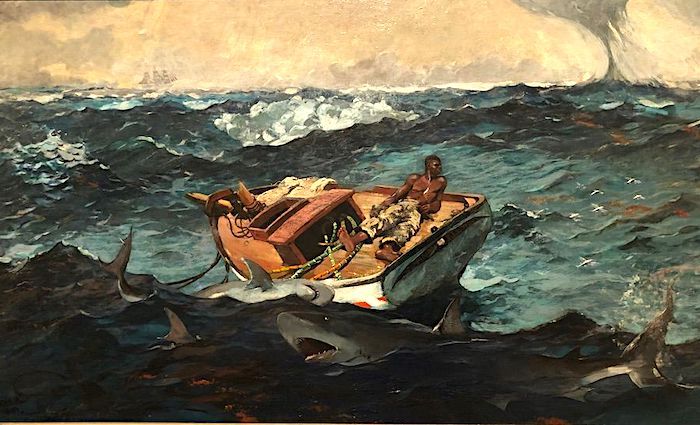
Winslow Homer | 1899 | Oil on Canvas | Gallery 767
“The Gulf Stream” predates the popular film ” Jaws” by almost 100 years, but the fear effect is similar. To be stranded at sea is bad enough, but adding hungry sharks to the mix is definitely worse. Personally, this ranks very high as one of my biggest fears!
In the later years of Winslow Homer’s life, he lived in almost total seclusion along the coast of Maine. While he was interested in the sea, in his later years he was almost obsessed with it and our vulnerability in regards to it.
He traveled many times during the winter to the Bahamas and there he found the inspiration for this painting. The gulf stream is the warm current that flows from the north of the Atlantic down to the Southern Atlantic.
In the painting, a man faces a fairly hopeless solution. The boat has suffered some calamity is without a mast and rudder. Next to his feet, you can see a few stalks of sugar cane which is the man’s only form of food. Unfortunately, unbeknownst to the man, is a ship in the distant horizon which Homer later added to the composition as a sign of hopeful rescue.
According to the MET Official Archives, ” Painted shortly after the death of his father, in 1898, the painting has been interpreted as an expression of the artist’s presumed sense of mortality and vulnerability”.
5. Winter
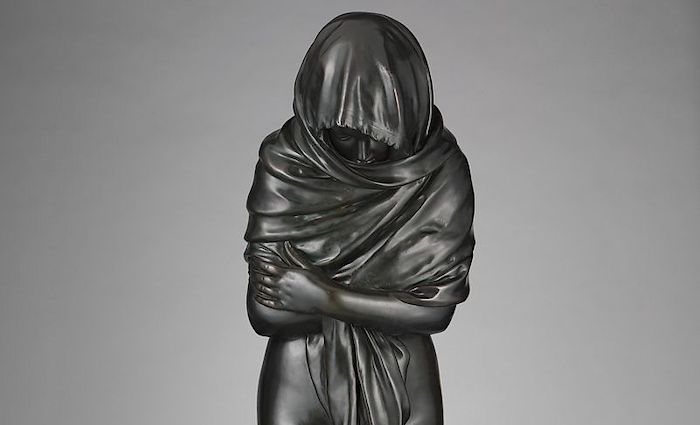
Jean Antoine Houdon | 1787 | Bronze
What feeling is worse than the biting cold? The humid cold goes right through your clothes, no matter how many layers you have on. As I have mentioned earlier the main two expressions in sculpture are joy and pain. The pain this woman is feeling from the cold is palpable. Even looking at it, makes me shiver now. It never ceases to amaze me the skill involved in bringing alive such emotion from a piece of cold metal.
Jean Antoine Houdon was surprisedly primarily known for his portraiture. I say surprisedly because this statue is not a portrait and is fascinating to look at. Houdon grew up in Versailles as the son of a servant. His father then served as a concierge for École des Élèves Protégés where recipients of the Prix de Rome were schooled. In this way, Houdon grew up surrounded by these budding artists and eventually received the prize himself in 1761.
Check Out Our Best New York City Tours

Top Rated Tour
Before the Crowds Statue of Liberty and Ellis Island Tour
On this tour you will visit the Statue of Liberty and Ellis Island with roundtrip ferry transport included all with a local guide who will describe the city’s amazing history as you visit the picturesque monument.





(10)
Starting at $59
Not ready to book a tour? Find out if a tour of the MET is worth it.
4. Venus Italica
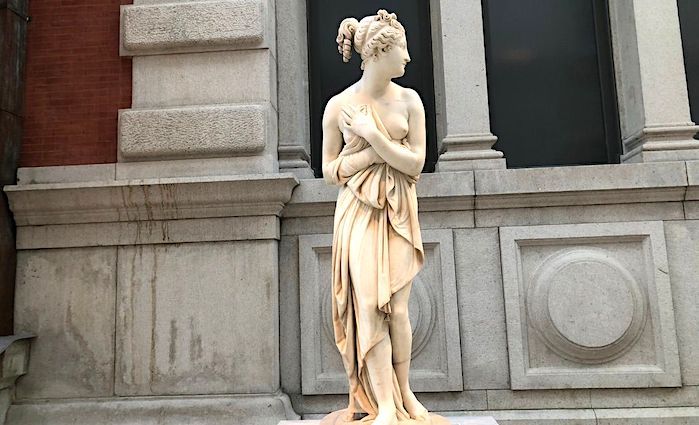
Workshop of Antonio Canova | ca. 1822–23 | Variant of Marble First Executed 1810 | Carrara Marble | Gallery 515
When I think of Antonio Canova, I envision a huge torch of greatness being passed down to him from his predecessors. In my head it is Donatello (15th century), passing it to Michelangelo (16th century), passing it to Bernini (17th century), passing it to him.
Don’t be put off by the fact this statue was done by his workshop. Successful artists had so many commissions it was impossible to do them all. The master would usually create the drawing and how it should be carved and the workshop took over. Similar to Steve Jobs creating the idea of the iPod, but engineers making it happen.
This ” Venus Italica” is actually the third Venus created by Canova. The first Venus is in the Palazzo Pitti in Florence. In 1804, Ludovico I, King of Etruria, ordered the second Venus as a replacement for the original Medici Venus taken by the French. The third Marquess of Londonderry purchased this replica in late 1826 or early 1827 where it remained until 1962.
Antonio Canova is considered the greatest Neoclassical sculptor of the late eighteenth and early nineteenth centuries. Along with the painter Jacques Louis David, he was credited with ushering in a new aesthetic of clear, regularized form and calm repose inspired by classical antiquities.
Christina Ferando, Department of European Sculpture and Decorative Arts, The Metropolitan Museum of Art
3. Julie Le Brun Looking In A Mirror
Elisabeth Louise Vigée Le Brun | 1787 | Oil on Canvas | Gallery 616
Elisabeth Louise Vigée Le Brun possessed a life made for a movie that you can actually watch on Amazon.
Le Brun is one of the finest 18th-century French painters and arguably one of the most important of all woman artists. She taught herself how to paint and was extremely talented. She lived during the turbulent times of the French Revolution and still, she achieved great success.
Elizabeth Le Brun married at 21 to a leading art dealer in Paris and due to his profession, she was not accepted at first into the prestigious Academie Royale de Peinture et de Sculpture. However, she just so happened to know Queen Marie Antoinette who knew a few people and was admitted at the age of 28.
Once the French Revolution broke out, she was forced to flee France since she was pretty tight with the Queen. She lived in Italy for a while before eventually returning to France.
Julie Le Brun Looking in a Mirror is an amazing representation of Le Brun’s only child. Le Brun made the same innovative portrait two years earlier of her daughter. The double image plays on reality versus illusion and shows even more so how talented an artist Le Brun really was. I chose this painting as number one, not only due to its uniqueness in character, but also its impossible perspective. Le Brun’s talent is truly on full display as one of the master portrait artists of the 18th century.
These portraits capture a new appreciation in late eighteenth-century Europe of childhood as a unique, impressionable moment of life distinct from adulthood.
MET Official Archives
2. Washington Crossing The Delaware

Emanuel Leutze | 1851 | Oil on Canvas | Gallery 760
Arguably one of the most famous pictures of American patriotism ( At least for me). “Washington Crossing the Delaware” is emblematic of perseverance in the face of great odds. This large canvas painting has been copied and recopied, parodied, and celebrated countless times in its history.
Though painted almost one hundred years after the events it depicts, the painting presents Washington’s perilous journey across the frozen Delaware river with immediacy and passion. Depleted and short on morale, the men of Washington’s company crossed Delaware in a surprise attack on enemy troops quartered in Trenton, New Jersey on Christmas Day 1776.
A fire actually damaged the painting in Leutze’s studio in 1850. It was again damaged in a bombing raid in 1942 and thankfully is still with us today! In 1851, Marshall, Marshall O. Roberts bought the painting for $10,000. According to Official Data, that would be a whopping $342k today!
1. The Death Of Socrates
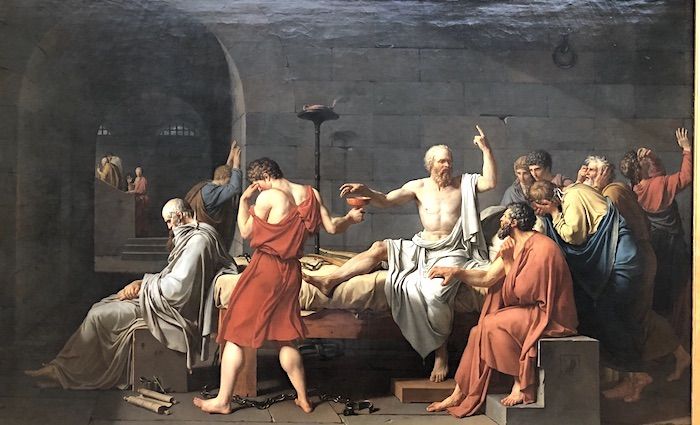
Jacques Louis David | 1787 | Oil on Canvas | Gallery 614
This touching painting will mean almost nothing to the viewer without context and knowing the story. For example, the painting could be a depiction of a group of classical-styled men having an interesting conversation. And at one point a servant gives the most important man in the center a cocktail ( wine back in the day). However, what that man is giving him is the poison hemlock!
Socrates (470-390 BC) was one of the most disruptive philosophers in classical times. His most famous student was Plato who recorded the death scene of Socrates in his work Phaedo. Convicted of impiety, he was sentenced to death. He could have recanted but seemed to die willingly by drinking the poison. As Plato tells it, Socrates surrounded himself by his closest pupils and discussed the immortality of the soul as he drunk the deadly elixir.
David lost his father to a duel ( still a thing back in the day). His uncles cared for him and, it was obvious that he possessed great talent in the arts. In his early artistic years, he had many trials and tribulations and even tried to commit suicide by starvation ( the stoic way). Eventually, he won a scholarship to study in Rome and that’s when he began to blossom.
David became one of the most important Neoclassicist painters of the period. For the Death of Socrates, he consulted antiquarian scholars in order to give a genuine representation of the furniture and even clothing of that time. During the revolution and after he became famous as the official painter of Napoleon and his masterpiece Coronation of Napoleon.
The art of antiquity will not seduce me, for it lacks liveliness
Jacques Louis David
Not ready to book a tour? Check out our MET Guide for more resources.

Where To Stay in NYC
New York City is the center of the universe to those who adore this iconic city. Choose the best neighborhood to stay in as you plan your upcoming trip to the Big Apple.
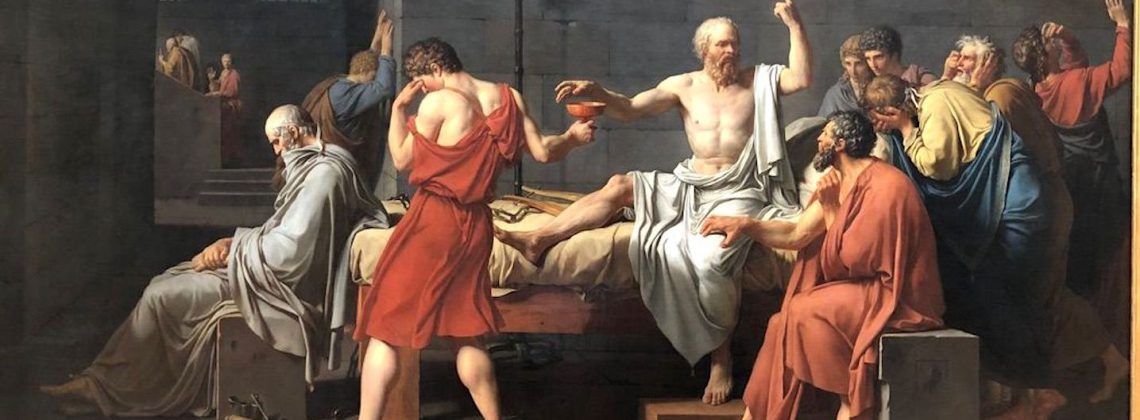
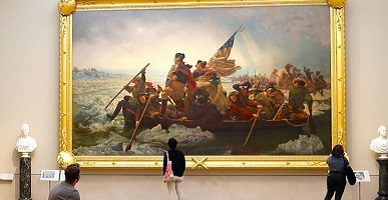
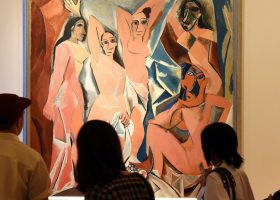
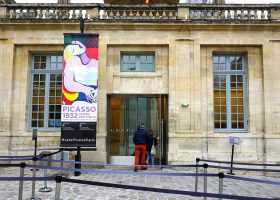



This list is bogus. Where is Vermeer’s “Woman with a Water Pitcher” or any of the other four in the collection? Van Gogh? The MET has a rich supply including “Self Portait,” “Shoes,” “Irises.” What of “The Princess de Broglie,” Boticelli’s “Annuciation,” Rembrant’s “Aristotle,” Cot’s “Storm?” Madame X herself would be gravely insulted at her exclusion. This is shabby, naive reporting. Pathetic.
How could you possibly leave out Van Gogh. Here is an artist who is well represented at the Met.
The Met is also lucky enough to count Vermeer in its collection.
This list incomplete.